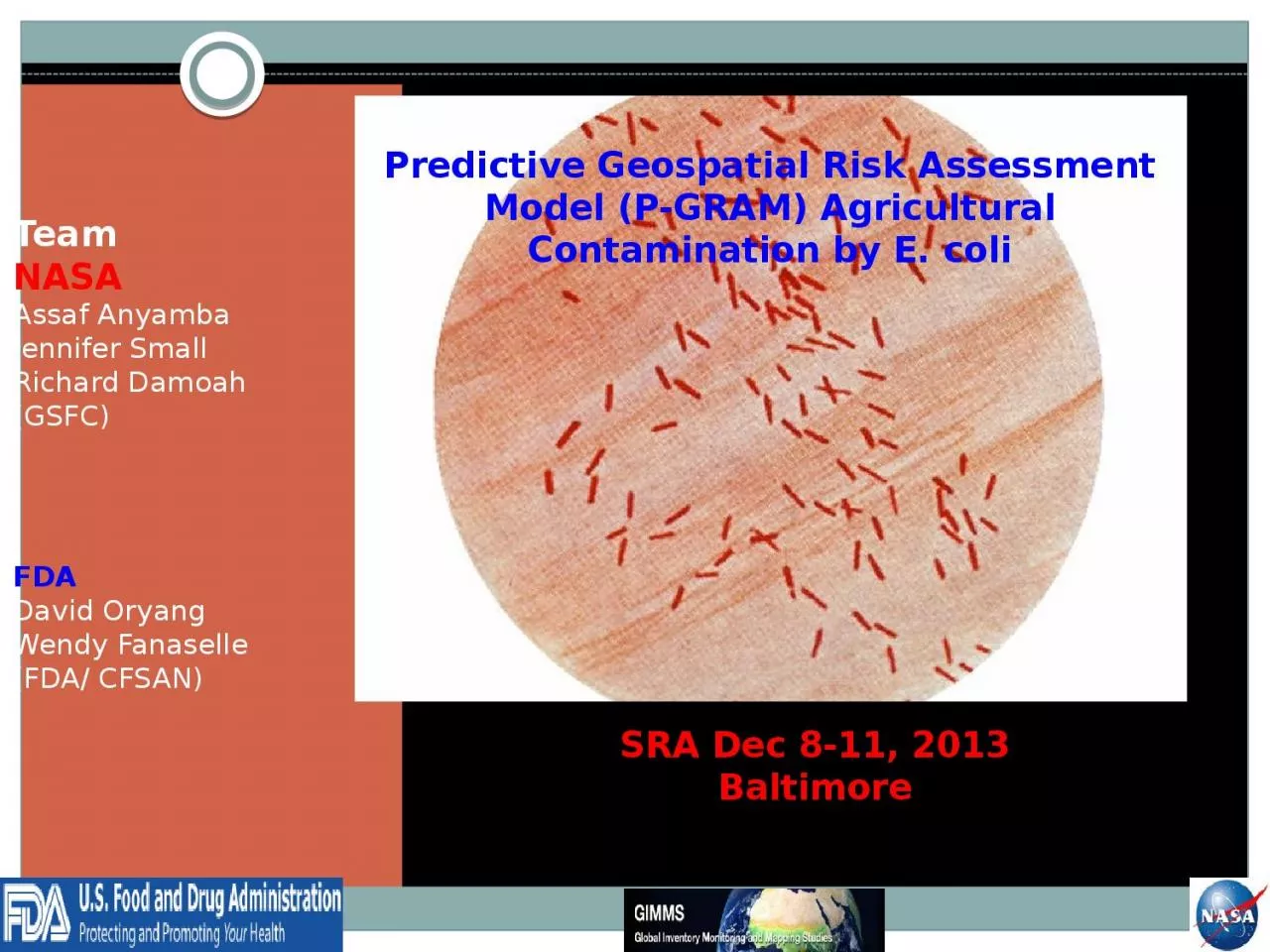

Richard Damoah GSFC FDA David Oryang Wendy Fanaselle FDA CFSAN September 2630 2010 Raleigh North Carolina Predictive Geospatial Risk Assessment Model PGRAM ID: 1044290
Download Presentation The PPT/PDF document "Team NASA Assaf Anyamba Jennifer Small" is the property of its rightful owner. Permission is granted to download and print the materials on this web site for personal, non-commercial use only, and to display it on your personal computer provided you do not modify the materials and that you retain all copyright notices contained in the materials. By downloading content from our website, you accept the terms of this agreement.
1. TeamNASAAssaf Anyamba Jennifer Small Richard Damoah(GSFC)FDADavid Oryang Wendy Fanaselle(FDA/ CFSAN)September 26-30, 2010 Raleigh, North CarolinaPredictive Geospatial Risk Assessment Model (P-GRAM) Agricultural Contamination by E. coliSRA Dec 8-11, 2013Baltimore
2. Background – driversPrecipitation as transport mechanismCooley, M. et al (2007). “Incidence and tracking of Escherichia coli O157:H7 in a major produce production region in California,” PLoS ONE, 11, e1159.
3. Seasonal Event DistributionImplications for pre-harvest contamination of cropsIncidence of environmental contamination peaks in spring, during rainy seasonReported outbreaks peak in fall, after dry periodRelationship between incidence of E. coli in the environment and the occurrence of actual outbreaks is not clearly understoodWe hypothesize that runoff in the spring deposits waste contaminated with E.coli near or in agricultural areas makes it possible for greens to be contaminated during the growing season
4. 2011 NASS Cropland Data Layer (NASS Cropland Layer updated annually)Crop mask contains all agricultural land instead of “fruits and vegetables” onlyIncludes feedlot, dairy and poultry locations from CA Dept of Water Resources Land Use Survey: http://www.water.ca.gov/landwateruse/lusrvymain.cfmCumulative precipitation and NDVI anomalies updated every 8 daysAnalysis Domain includes CA, NV, AZFrom Rangel et al, 2005Spatial Risk Model: PGRAM
5. Seasonality Growing Season: September to May: Rain-fed Agriculture Irrigation – year round? Risk classification is based on evaluating rainfall leading indicators (precipitation and NDVI) Overland runoff leads to accumulation of fecal matter and other waste in zones of potential contamination Rainfall risk category classification 32 day cumulative total at least 21.3 mm High risk if anomaly at least 30% Moderate risk if anomaly at least 15% Low risk if anomaly at least 5% NDVI risk category classification 32 day cumulative total at least 0.2 High risk if anomaly at least 20% Moderate risk if anomaly at least 10% Low risk if anomaly at least 5% Overall risk is the maximum of the rainfall and NDVI risk classifications
6. Overview MapOverview map goes here
7. Salinas Valley: June 10 - July 11, 2013
8. Imperial Valley: June 18 – July 19, 2013
9. ARS/FDA Environmental Sampling2011/2012 for Validation“Salad bowl of America” Since 1996, at least 11 outbreaks of E. coli have been traced to the Salinas ValleyMonth-YearLocation of outbreakNo. of IllKnown or suspected vehicleMay-96IL, CT61Lettuce, Mesclun mixSep-99CA8Lettuce, RomaineSep-99WA6Lettuce, RomaineOct-99OR3Lettuce, Romaine heartsOct-99PA41Lettuce, RomaineJul-02WA29Lettuce, RomaineNov-02 * San Joaquin ValleyIL,WI,MN,SD,UT24LettuceSep-03CA57Lettuce, Iceberg/RomaineOct-03CA16SpinachNov-04NJ6LettuceSep-05MN11Romaine,also vegetablesAug/Sep-0626 states>200Spinach, baby, baggedMay-08WA10 Source: Mandrell, R. E. 2009. Enteric human pathogens associated with fresh produce: sources, transport, and ecology. In Microbial Safety of Fresh Produce, ed. Xuetong Fan, Brendan A. Niemira, and Christopher J. Doona, 5-41. John Wiley and Sons, September 15.
10. ARS/FDA Environmental Sampling2011/2012PathogenPositive Samples# Samples% PositiveNoroVirus-G184391.82NoroVirus-G26943915.72ECO157537227.34Listeria28363844.36Salmonella44268864.24STECs7367910.75SUMMARY: RESULTS
11. Rainfall @ ECO157 Positive Site
12. Rainfall @ ECO157 Site
13. Relative Humidity ConditionsRegions withElevation higher than 1000 hPa are shown with no data Instrument(AIRS) Atmospheric Infrared Sounder aboard AquaLaunch date May 4, 2002Orbit 705 kmSwath width 1650 km Ground coverage >95% global dailyGridded products (Level 3)1º x 1º — daily, 8-day and monthly.• Temperature profiles (24 levels, to 1 mb)• Moisture profiles (12 layers, to 100 mb)• Outgoing long-wave radiation• Surface temperatures
14. Salinas Valley: Relative Humidity Anomalies
15. RH and Temperature Trends
16. DATERH ANOMALY (%)TEMP. ANOMALY (K)Oct. 20119.4-1.06Nov. 20113.9-2.65Dec. 2011-5.71.99Jan. 2012-2.82.05Feb. 2012-2.00.48Mar. 201211.0-2.45Apr. 20125.10.11May 20125.90.68Jun. 201212.1-1.17Jul. 20129.3-3.85Aug. 20124.81.05Sep. 201213.0-2.28Oct. 201213.6-0.43Nov. 20123.40.39Dec. 201212.4-4.37Green highlight shows month with no Pathogen DetectionSummary: RH and T
17. PGRAM Risk Maps are currently being generated in experimental mode for FDA to monitor at risk areas Planned improvements will incorporate detailed livestock location data from ARS FLAPS project to enable improved risk characterizationDaily rainfall and Cumulative rainfall anomalies can be use as a general indicator of areas of potential pathogen riskGenerally positive pathogen detections show a positive correlation with RH anomaly. In summer pathogen detections are concentrated in the northern part of region (Salinas Valley) while in winter the detections shift to southeast (Imperial Valley). This is due to the shift of high RH anomaly from north to southeast in winter.There is need for systematically sampled and geo-referenced produce data on ECO157/Salmonella etc.. from Industry providers for validation.SUMMARY